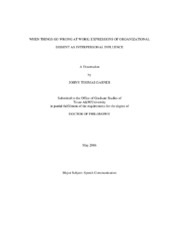| dc.description.abstract | This dissertation examines the types of messages used for organizational dissent,
and argues for connections between dissent messages, choice of audience and influence
goals. The organizational dissent literature has explored the situations that may trigger
dissent and the variables that lead a dissenter to approach various audiences, but few
studies have examined dissent messages. Additionally, this line of research has tended
to neglect coworkers as a possible audience for dissent and has been characterized as
atheoretical (Waldron, 1999). Much of the research on interpersonal influence has
examined influence in romantic relationships, but influence may play an important role
in workplace relationships as well, suggesting that interpersonal influence is an
appropriate theoretical perspective from which to examine dissent. This dissertation
examines the messages, audiences, and goals associated with dissent using a two-part
study with interviews and surveys.
Messages differed according to audience, but, surprisingly, not according to the
quality of relationship between the dissenter and the audience. Dissent expressed to
supervisors is more likely to involve message types such as assertiveness, rational arguments, solution presentation, humor, ingratiation, sanctions, threatening resignation,
while dissent expressed to coworkers is more likely to involve message types such as
displaying emotion or coalitions. The primary goal of expressing emotion and the
secondary goal of identity were most prevalent in terms of considerations as study
participants expressed dissent. The analyses indicate that the goal of expressing emotion
was significantly related to messages of displaying emotion, goals of providing guidance
or changing opinion were significantly more associated with solution presentation than
with asking for information, the goal of gaining assistance was significantly more
associated with coalitions, and the goal of relational resource was significantly less
associated with messages threatening resignation. These results suggest that
interpersonal influence offers a fruitful perspective from which to view dissent
messages, and more research is needed to examine the goals associated with workplace
influence as the goals that motivate interpersonal interactions differ from the goals that
motivate organizational dissent. Additionally, these results indicate that the position of a
person is more important than a relationship in determining how a person will express
dissent. | en |


